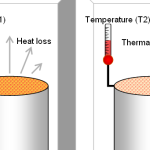To understand what specific heat is, let us consider the example of the metallic rod, which is being heated. As it is heated its temperature increases, the amount of heat required to raise its temperature by one degree Celsius or Kelvin is the specific heat of the rod. In general, the amount of heat required to raise the temperature of unit mass of the substance by unit degree is called as the specific heat of the substance.
The substances that have low specific tend to get heated and cooled faster; hence they need less heat to raise their temperature by unit degree. The substances with high specific heat tend to get heated and cooled slowly; hence they need more heat to raise their temperature by unit degree.
The specific heat of the substance is denoted by the ‘c’. The specific of almost all the substance including metals, alloys, compounds solutions, gases, liquids etc can be measured.
For the gases there are two types of specific heats depending on the type of process. The specific heat of the gas at constant pressure is denoted by cp, while the specific heat at constant volume is denoted by cv. For the solid substances the specific does not depend on the type of the process. The unit of measurement of specific heat is J/kg.K. The specific heat of water is 1 calorie/gram degree C = 4.186 joule/gram degree C
Heat Absorbed by the Substance
The amount of heat (Q) absorbed by the substance depends on the specific heat of the substance and the difference between initial and final temperature of the substance. Its value is given by:
Q = m*c*∆T measure in J or KJ
Where: m is the mass of the substance in Kg and ∆T is the change in temperature of the substance measured in degree Celsius or Kelvin. The product m*c is also called as the heat capacity of the substance and it is denoted by C, Cp or Cv depending on the type of process.
Relation between Specific Heat of Gas at Constant Pressure and Constant Volume
For the gases it is easier to measure specific heat at constant pressure and constant volume. Here is the relation between specific heat at constant pressure and constant volume for the ideal gas:
cp-cv = R
Where R is the gas constant for ideal gas.
Cp/Cv = √ (gamma)
Where value of gamma is greater than unity and keeps on changing depending on the type of gas.



Comments are closed